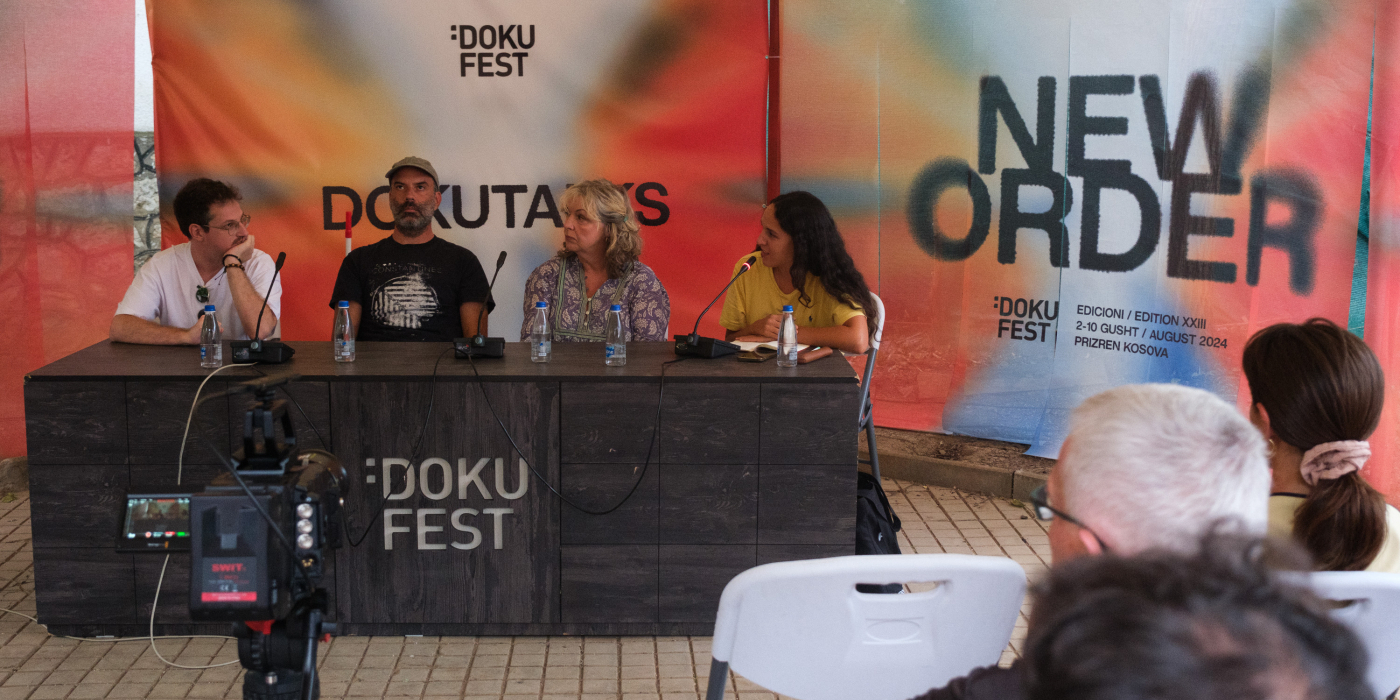09/08/2024
Walking up and down a film festival for six consecutive days makes one realize just how deeply engaged one becomes in the act of looking. In an intense, eight-day program, despite moments dedicated to listening or participating in conversations, the primary activity remains seeing and all that it entails. What about the filmmakers who engage in a similar activity throughout their filmmaking process? DokuFest’s 6th DokuTalk focuses precisely on the matter of intimacy in observational filmmaking and the dilemmas faced when developing a story and spending time with characters.
To initiate the discussion, moderator Dea Gjinovci expressed her fascination with the process of working with characters, particularly in terms of creating intimacy and connection. For Eneos Çarka, filmmaker of Another Day, which is competing in the Balkan Dox program, his approach to filmmaking involves meeting and engaging with characters. Although Rafael, one of the main characters in Another Day, reached out to Eneos after becoming acquainted with his work at the university, their established intimacy in the common existing environment facilitated the creative process. Rafael’s interest in performance and Eneos’ method of observational filmmaking created a collaborative dynamic. For Birgitte Stærmose, filmmaker of Afterwar, also part of the Balkan Dox competition, filmmaking goes beyond mere observation due to her pre-existing relationships with her subjects. She does not consider herself an observational documentarian and describes herself as a “fiction” director who employs a more dissociative method throughout the filmmaking process. Pablo Alvarez Mesa, filmmaker and cinematographer of Adrienne & The Castle, emphasizes his role as a DOP in engaging with characters in a distinctive manner. He notes that by involving humans through various gestures, forms, and objects, he avoids projecting his own needs onto the characters. This approach respects their traits of grief or totalizing subjects without compromising their characterization.
On the subject of taking space on the movie set, Pablo emphasizes that “listening is 90% of shooting,” and being emotionally present with the character is crucial. He prefers using images as subtle pointers and deepening the emotional space through sound. In contrast to Pablo’s method, Brigitte’s film is performative, scripted, and directed, which results in extensive discussions about the nature of the performative space, including the roles of image, movement, and camera. She recognizes that documentary filmmakers face the dilemma of giving up control while being on camera, while she herself has chosen to direct the film out of a desire for aesthetic and emotional immersion, achievable only through performance. For Eneos, the specific aspects of observational filmmaking were not a point of discussion at the beginning of his project. Initially inspired by street photography, he acknowledges that his aesthetic values evolved over time. Eneos wanted to move beyond traditional documentary confines and states, “Character study doesn’t work in documentary; I am not building characters, I am existing together with people who also exist beyond the documentary space.” This approach led to two significant outcomes for Eneos: focusing on preserving the dignity of street performers and challenging the Western portrayal of Albanian men in contemporary cinema.
The responsibility of representation in film involves portraying individuals in a timeless manner. Brigitte believes that “people’s lives are bigger than film” and feels it is pompous to claim responsibility for someone’s life stories. This is why her stories are “about everyone and no one in particular,” reflecting ethical considerations and giving agency to the individuals portrayed. The process of co-creation and the time dimension of Afterwar—spanning 15 years—shaped the filmmaking process, with witnessing becoming part of the form.
In one way or another, the film form must respond to the necessity of working with people. For Eneos, adapting the form during editing was crucial: “Documentary filmmaking can be reinvented throughout the making process, including during editing.” Pablo’s work as a DP on Adrienne & The Castle documents the co-creation process in a way that raises new questions and hides away the answers to those questions. The film explores layers of performance and non-performance, fiction and non-fiction, and everything that happens in between. The deep empathy that drives exploration into the depths of life underscores the importance of being truthful about the ambiguities of our performance in life.
In observational filmmaking, the ambiguity of truth is significant because art imitates life. Despite the importance of narrative structures in art studies, it is vital to leave room for doubt, uncertainty, and discovery. Working with reality involves “(un)happy accidents,” as Eneos describes them, which create ongoing obstacles and encourage openness to different forms and experiments. Ultimately, the best outcomes from observational filmmaking are the relationships formed during the process, which continue to persist even after the filmmaking part is long finished.
By: Enxhi Noni
Photo: Luka Knežević Strika



